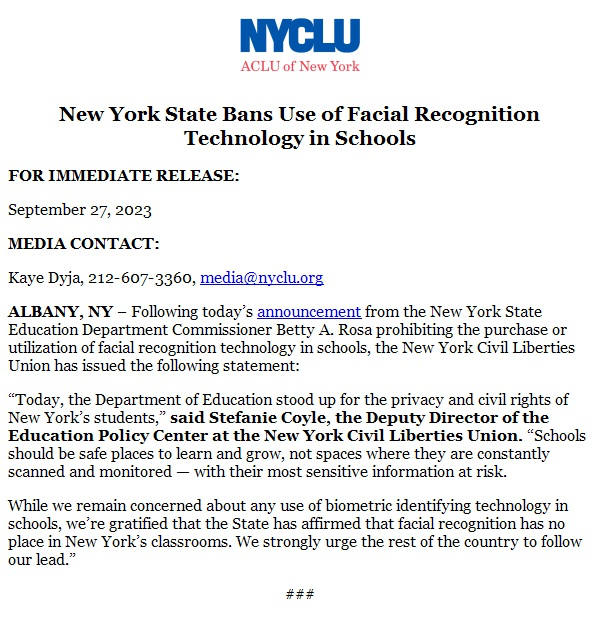The authentication process in US schools will see a change because of the landmark facial recognition ban by the education department. After seeing cases of accusations being made against six people in the United States based on facial recognition scans, the New York State Education Department took a stand against it
Education Minister Betty Rosa banned facial recognition technology in state schools. State schools must now stop the use of such technology after the facial recognition ban.
Facial Recognition Banned in Schools
Both public and private schools are prohibited from buying facial recognition technology. Other biometric identification tools can still be continued under specific circumstances while following the facial recognition ban. When the use of facial recognition was accepted in Lockport High School in 2020, parents and guardians of students protested it.
A guardian of a student, Jim Schultz who felt strongly against it said to The Buffalo News, “I’m a parent, I’m a grandparent. We want our kids to be safe in school. We need to do that in a way that’s smart, not stupid, and this was stupid from the beginning.”

The New York Civil Liberties Union (NYCLU), which is the New York state affiliate of the American Civil Liberties Union of Michigan (ACLU) both American nonprofits for human rights, celebrated the landmark facial recognition ban. They wrote, “New York just became the first state in the nation to ban the use of facial recognition technology in schools.”
False Positives a Growing Concern with Facial Recognition Tech
An eight-month pregnant black woman suffered an arrest due to a case of facial recognition mishap that falsely identified her with an accused in a carjacking case. The woman who is from Detroit decided to take the matter to court.
Porcha Woodruff who had to stay in custody for hours in her condition sued the Detroit Police Department. Her attorney, Phil Mayor expressed his concerns about the unfortunate actions on the plaintiff.
He said, “In the Ms. Woodruff case, assuming the facts alleged there are true, she was eight months pregnant. All they had to do was literally look at her and look at the video of the incident to determine the suspect was not, in fact, pregnant.”
There have been six cases of misidentification attributed to faulty facial recognition and all were pertaining to black people. Two cases were filed against the Detroit Police Department (DPD).
Phil Mayor is also representing Robert Willaims who filed a lawsuit against the DPD a few years back. Robert was the first reported victim who was misidentified and arrested by the DPD. Robert was arrested for someone who was on the police radar for stealing watches.
He pleaded that the DPD relied on the facial recognition technology and did not conduct any further investigation.
Where Facial Recognition is Not Enough
Reacting to faulty facial recognition technology, Phil Mayor said, “It’s technology that misidentifies people with black faces at a particularly high rate, and they are insisting that technology in one of the most aggressive ways possible in one of the Blackest cities in America.”
Showing concerns over the inept use of technology, Detroit Police Chief James White said that he was looking for the possibilities of misuse of the policy. “We are going to take this seriously,” James White concluded.
Addressing the possibility of higher number of unrecorded cases, Phil Mayor said, “We don’t know how many are actually convicted of crimes and sitting behind bars….”
The use of authentication was aimed at aptly allowing the rightful person and stopping others. The intent of adding facial recognition in schools could have been to stop hackers and criminals walking in with weapons. However, when technology stops if race or age confuses it, manual intervention is critical.
Media Disclaimer: This report is based on internal and external research obtained through various means. The information provided is for reference purposes only, and users bear full responsibility for their reliance on it. The Cyber Express assumes no liability for the accuracy or consequences of using this information.
